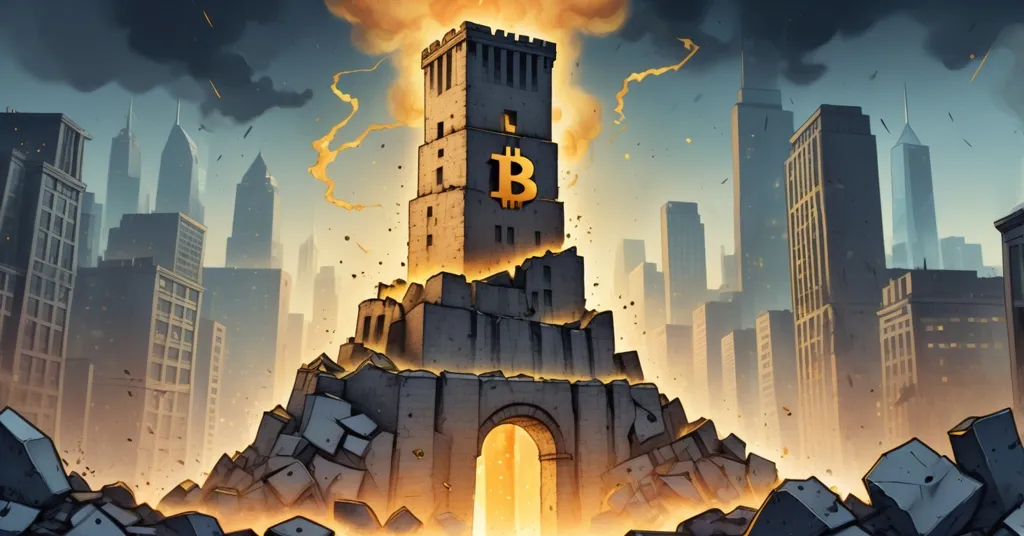Fed Trust Plummets to 37%: Powell Crisis Fuels Bitcoin’s Decentralization Case

Trust in Fed Crashes to 37%: Powell Faces Historic Low as Bitcoin’s Case Strengthens
Public faith in Federal Reserve Chair Jerome Powell has nosedived to a mere 37%, one of the lowest approval ratings ever for a Fed Chair, according to a Gallup survey from April 2023. With economic headwinds like stubborn inflation and a wobbly labor market, Powell’s hints at interest rate cuts during the Jackson Hole symposium have rattled markets and amplified political meddling, spotlighting the fragility of centralized finance and bolstering the argument for decentralized alternatives like Bitcoin.
- Historic Distrust: Only 37% of Americans trust Powell to guide the economy, per Gallup.
- Rate Cut Signals: Powell suggested potential cuts at Jackson Hole, triggering market volatility.
- Political Threat: Trump’s attacks and appointments jeopardize the Fed’s independence.
Why This Matters
The Federal Reserve’s role as the backbone of U.S. monetary policy is under unprecedented scrutiny. As trust erodes, the implications ripple beyond traditional markets to the very foundation of centralized finance—a system Bitcoin and blockchain technologies were built to challenge. This convergence of economic uncertainty and political overreach isn’t just a headline; it’s a glaring reminder of why decentralization matters now more than ever.
Powell’s Trust Crisis: A Damning Statistic
The numbers are stark and unforgiving. Gallup’s latest poll reveals that just 37% of Americans trust Powell to guide the economy. This isn’t just a personal failing—it’s a historic low, tying with Janet Yellen’s dismal 37% in 2014 and a sharp plunge from Powell’s 58% approval in 2020 during the early Trump years. For context, this level of distrust hasn’t been seen since the aftermath of the 2008 financial crisis under Ben Bernanke, though even then, confidence rarely dipped below 40%. Today, with inflation still gnawing at wallets and fears of recession looming, fewer than four in ten people have faith in the Fed’s leadership. For Bitcoin advocates, this is a screaming indictment of fiat systems—centralized control is faltering, and the public knows it.
Breaking this down by demographics adds salt to the wound. Gallup data comparing Powell to Yellen in 2014 shows a partisan chasm: Democrats, under Biden, muster around 66% confidence in Powell, while Republicans scrape a pitiful 28%. Compare that to the Trump era, when Republican trust soared to 62% and Democrats lagged at 48%. This flip-flop isn’t just politics—it’s a symptom of how deeply divided and politicized perceptions of economic stewardship have become. When trust in a supposedly neutral institution splits along party lines, its credibility as an impartial arbiter takes a brutal hit.
Rate Cuts: Economic Lifeline or Policy Disaster?
The U.S. economy is on a knife-edge. Inflation, though cooling, still lingers above the Fed’s 2% target, while GDP growth limped along at 1.1% in Q1 2023. High interest rates, deployed to tame prices, risk choking growth and spiking unemployment. Against this backdrop, Powell’s speech at the Jackson Hole symposium in August 2023—a marquee event for global economic minds—dropped a bombshell. He hinted at interest rate cuts, possibly as early as September, though he hedged his bets, stressing “changing economic factors” and the need for incoming data. Translation: no promises, just a tease.
Markets didn’t wait for clarity. The dollar weakened, meaning it buys less on the global stage, often nudging investors toward hedges like gold or Bitcoin. Bonds surged, with prices rising as yields dropped on bets of cheaper borrowing. Stocks, too, rebounded, sniffing an easier money environment. But here’s the rub—Bank of America analysts aren’t popping champagne. They warn that slashing rates before key data, like the August jobs report, could be a catastrophic misstep. If the labor market unexpectedly tightens while inflation stays sticky, cutting rates might reignite price spirals. Powell seems to get the stakes, vowing to battle inflation “come what may” while admitting he’s “watching the labor market closely because it can unravel fast.”
So, are we on the brink of relief or a debt-fueled disaster? History offers cautionary tales—premature easing in the 1970s under Arthur Burns fueled stagflation, a nasty mix of high prices and low growth. For crypto enthusiasts, this uncertainty cuts both ways: runaway inflation could cement Bitcoin as an inflation hedge with its fixed 21 million cap, unlike the dollar which can be printed at will. Yet, if Powell’s interest rate cuts in 2023 stabilize markets and dodge a recession, the rush to decentralized assets might cool off temporarily. It’s a high-wire act with no net.
Political Meddling: The Fed Under Siege
The Federal Reserve was forged to stand above politics, making data-driven calls for long-term stability, not short-term populist wins. Its independence is sacrosanct—central bank autonomy correlates with lower inflation, as seen in historical data across advanced economies. Look at Turkey or Argentina, where political interference has tanked currencies and triggered capital flight. Yet, in the U.S., that firewall is crumbling, and Donald Trump is challenging the Fed’s independence with relentless pressure.
Trump’s disdain for Powell is no secret. He’s slung insults, demanded resignations, and fumed over past rate hikes that clashed with his growth agenda. It’s not just rhetoric—Trump has targeted Fed board member Lisa Cook over alleged mortgage paperwork discrepancies and slotted allies like Stephen Miran into temporary Fed roles. Miran, for the record, has argued for presidential power to fire central bank officials. Even the Bureau of Labor Statistics, a critical data source, now has a Trump loyalist at the helm. This isn’t subtle; it’s a blatant assault on neutral monetary policy.
“The Fed is supposed to operate outside of politics. But by the time next year’s Jackson Hole meeting happens, there’s every reason to believe the Fed will look very different.”
Bond markets are already sounding alarms. Long-term U.S. government bonds, essentially loans to the government over decades, are losing value compared to short-term debt. This “underperformance” signals investor dread of politically driven low interest rates that could balloon national debt and stoke inflation. As one observer noted, “If borrowing stays cheap, Trump can keep spending big without raising taxes. That’s the real game here.” Losing Fed independence isn’t just a domestic headache—if the dollar’s reserve currency status wavers due to eroded credibility, the global financial order could tremble.
Bitcoin’s Moment: Decentralization’s Rising Appeal
For those of us championing decentralization, the Fed’s woes are a megaphone blasting Bitcoin’s core thesis. Born from the ashes of the 2008 crisis, Bitcoin emerged as a middle finger to centralized bailouts and opaque policymaking. With only 37% of Americans backing Jerome Powell, and political fingers tightening around the Fed’s throat, the case for a censorship-resistant, fixed-supply asset grows louder. A weakening dollar, as seen after Powell’s speech, often correlates with Bitcoin price bumps—investors flee fiat volatility for something no politician can inflate away. While exact data post-Jackson Hole shows only modest BTC gains, the trend is clear: fiat uncertainty is crypto’s oxygen.
But let’s not get drunk on hopium. If premature rate cuts—or political pressure—stabilize traditional markets, the immediate panic driving folks to Bitcoin could taper off. Scalability hiccups, like Bitcoin’s slow transaction speeds compared to Visa, and looming regulatory crackdowns could also stall mainstream uptake. Plus, a compromised Fed might, under certain leadership, push crypto-friendly policies, blurring the line between centralized control and decentralized freedom. It’s not a straight shot to the moon—more like a chessboard with hidden traps.
Beyond Bitcoin: Altcoins and Blockchain in the Mix
While Bitcoin maximalists might scoff, other blockchain players could carve niches amid Fed turmoil. Ethereum, with its smart contracts, offers decentralized lending and financial tools that could rival traditional banking if Fed policies destabilize credit markets. Stablecoins, pegged to fiat but running on blockchain rails, provide a middle ground—fiat-like stability without full exposure to central bank whims. These aren’t Bitcoin, and they shouldn’t be; they fill gaps BTC wasn’t designed for, like day-to-day transactions or complex DeFi protocols. A trust crisis in centralized finance doesn’t just lift Bitcoin—it raises all boats in the decentralized harbor, assuming regulators don’t sink them first.
What This Means for Crypto Investors
The Fed’s predicament isn’t abstract—it’s a live experiment in centralized failure. For crypto holders, a weakening dollar or inflation fears could spur short-term Bitcoin demand; historical spikes during past fiat crises, like the 2020 COVID money printing spree, saw BTC soar past $20,000. But don’t bet the farm on instant gains—market stability or regulatory backlash could mute the rally. Longer term, if Fed independence crumbles, we might face capital controls or currency devaluation, scenarios where Bitcoin shines as a hedge against Fed policies. On the flip side, a politicized Fed could unpredictably pivot to crypto hostility or co-option, muddying the waters. Stack sats if you’re bullish, but keep your eyes peeled—this game’s far from over.
Key Takeaways and Questions to Ponder
- Why has trust in Jerome Powell plummeted to a historic 37%?
Persistent inflation, high interest rates, and labor market fears have fueled public frustration, signaling deep distrust in centralized financial systems like the Fed.
- What dangers lurk in the Fed’s hinted 2023 interest rate cuts?
Cutting rates too soon risks reigniting inflation if job data surprises upward, a potential policy blunder flagged by Bank of America analysts.
- How does political interference threaten Federal Reserve independence?
Trump’s criticism of Powell and placement of loyalists like Stephen Miran shift the Fed toward politically motivated decisions, undermining data-driven policy.
- Can Fed turmoil accelerate Bitcoin adoption as a fiat alternative?
Yes, declining trust and dollar volatility could drive investors to Bitcoin as a decentralized hedge, though short-term market stability might slow the shift. Insights on Powell’s trust rating impacting Bitcoin highlight community perspectives.
- What global risks arise from losing central bank independence?
A compromised Fed could face fiscal dominance, leading to unchecked debt, inflation surges, and eroded dollar credibility, mirroring crises in Turkey and Argentina. Discussions on Fed independence influencing Bitcoin adoption explore potential outcomes.
- How do altcoins and blockchain tech fit into a Fed trust crisis?
Ethereum’s DeFi tools and stablecoins offer decentralized alternatives to traditional finance, filling niches Bitcoin doesn’t cover as trust in fiat wanes.
The Fed teeters on a precipice, with trust at rock bottom and political shadows growing longer. For Bitcoin maximalists and decentralization diehards, this is vindication—centralized finance is cracking under its own weight. Yet, the road to mass crypto adoption isn’t a victory lap; it’s a gauntlet of economic twists and regulatory landmines. As Powell navigates this mess, one thing is crystal clear: the flaws of fiat are glaring, and if the Fed’s autonomy keeps slipping, more folks might just vote with their wallets for a system no one can rig. Will Bitcoin become the ultimate protest against centralized failure, or are we overestimating its readiness to replace the old guard? Time, and the blockchain, will tell.



